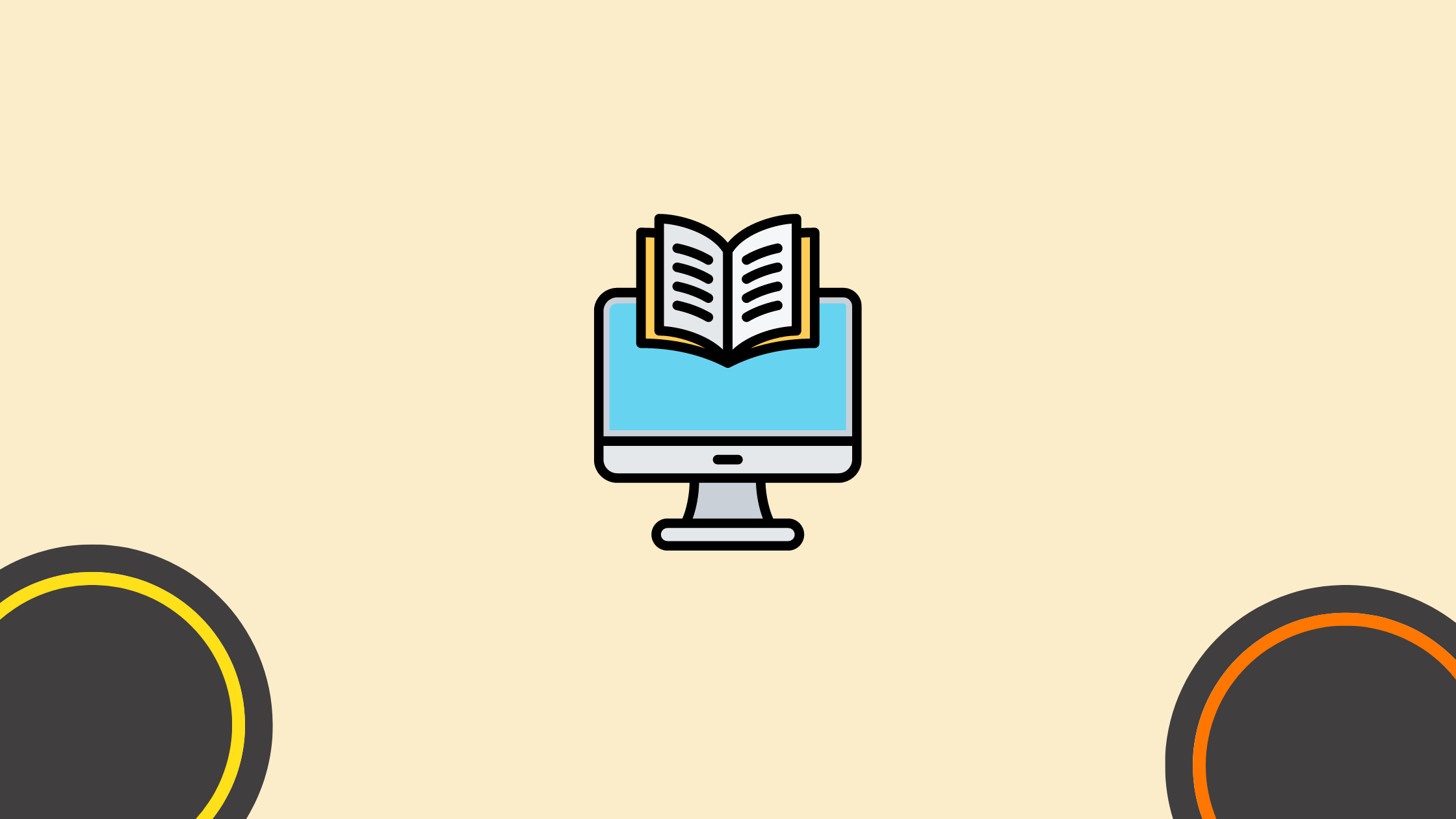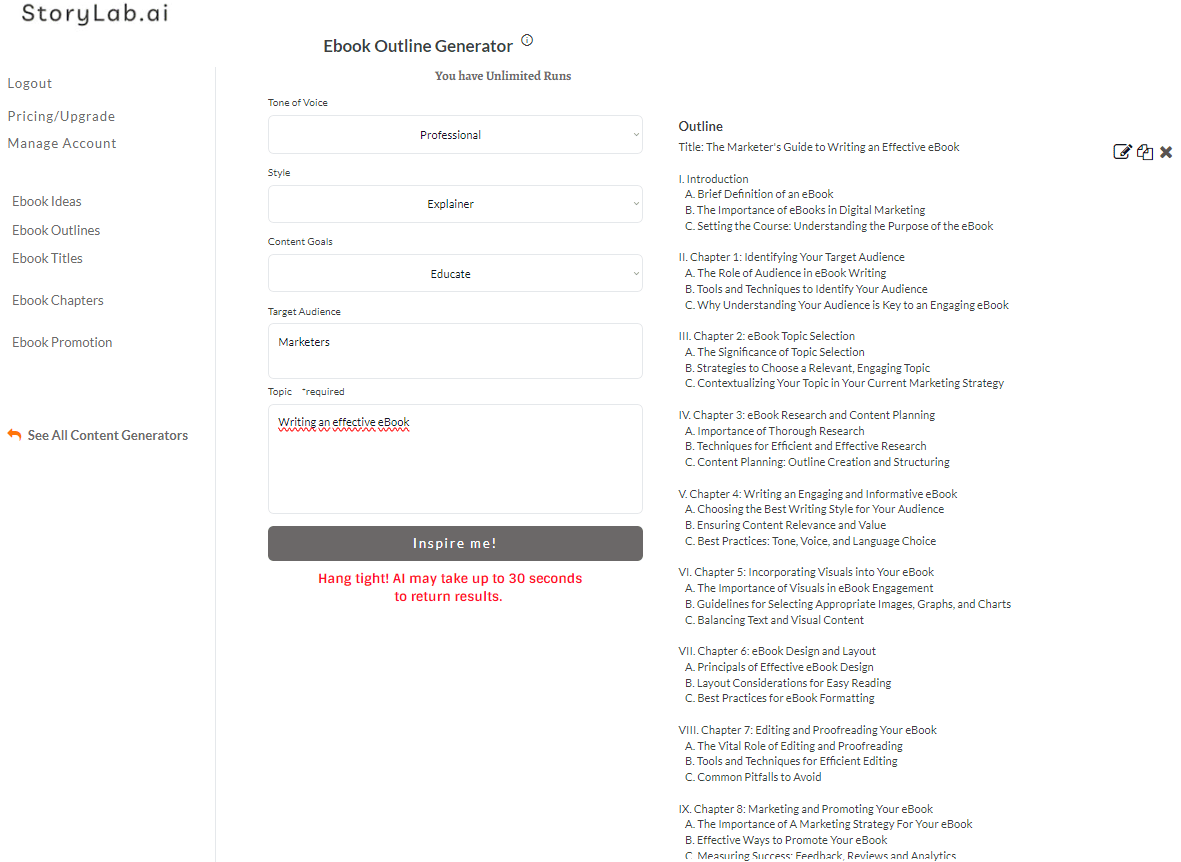What Is StoryLab.ai’s AI eBook Outline Generator?
Our eBook Outline Generator is powered by AI and helps you come up with a great structure (outline) for your eBook. After using our AI eBook Outline Creator, you can easily start to use our other AI tools to create your eBook Chapters, Titles, and promotion material.
Get started for free with the AI eBook Outline Generator And create more effective eBooks faster than ever before.
Try it out for yourself!
Benefits of AI-Powered eBook Outline Generator
Our eBook Outline Generator gives you detailed chapters and subchapters you can use for your eBook. We advise using our complete AI Toolset to finish your eBook faster than ever before but always add your unique human touch. Use AI to inspire you on your creative journey.
Top benefits of the AI eBook Outline Generator
 AI modes AI modes |
13 writing styles |
 Improves Improves |
Copy, creativity, and more |
 Support Support |
17+ Languages |
 Price Price |
Free and Premium |

Chapters
- Que es StoryLab.ai¿El generador de esquemas de libros electrónicos con IA?
- Beneficios del generador de esquemas de libros electrónicos impulsado por IA
- Cómo empezar con el generador de esquemas de libros electrónicos con IA
- Mejores prácticas para crear un esquema de libro electrónico
- Precios del generador de esquemas de libros electrónicos con IA
How to start with the AI eBook Outline Generator
Start by creating a free account at StoryLab.ai and select the AI eBook Outline Generator. You get 3 free runs every month and can upgrade if you need more.
Then, enter your prompts to get a detailed outline. Here’s an example of what we’ve entered and what the AI eBook Outline Makere came up with on the first run. Our inputs:
- Tone of voice: Professional
- Style: Explainer
- Content goals: Educate
- Target audience: Marketers
- Topic: Writing an effective eBook
Here’s what the AI Tool came up with:

eBook Outline Generator output example
Outline
Title: The Marketer’s Guide to Writing an Effective eBook
I. Introduction
A. Brief Definition of an eBook
B. The Importance of eBooks in Digital Marketing
C. Setting the Course: Understanding the Purpose of the eBook
II. Chapter 1: Identifying Your Target Audience
A. The Role of Audience in eBook Writing
B. Tools and Techniques to Identify Your Audience
C. Why Understanding Your Audience is Key to an Engaging eBook
III. Chapter 2: eBook Topic Selection
A. The Significance of Topic Selection
B. Strategies to Choose a Relevant, Engaging Topic
C. Contextualizing Your Topic in Your Current Marketing Strategy
IV. Chapter 3: eBook Research and Content Planning
A. Importance of Thorough Research
B. Techniques for Efficient and Effective Research
C. Content Planning: Outline Creation and Structuring
V. Chapter 4: Writing an Engaging and Informative eBook
A. Choosing the Best Writing Style for Your Audience
B. Ensuring Content Relevance and Value
C. Best Practices: Tone, Voice, and Language Choice
VI. Chapter 5: Incorporating Visuals into Your eBook
A. The Importance of Visuals in eBook Engagement
B. Guidelines for Selecting Appropriate Images, Graphs, and Charts
C. Balancing Text and Visual Content
VII. Chapter 6: eBook Design and Layout
A. Principals of Effective eBook Design
B. Layout Considerations for Easy Reading
C. Best Practices for eBook Formatting
VIII. Chapter 7: Editing and Proofreading Your eBook
A. The Vital Role of Editing and Proofreading
B. Tools and Techniques for Efficient Editing
C. Common Pitfalls to Avoid
IX. Chapter 8: Marketing and Promoting Your eBook
A. The Importance of A Marketing Strategy For Your eBook
B. Effective Ways to Promote Your eBook
C. Measuring Success: Feedback, Reviews and Analytics
X. Conclusion
A. Recap of the eBook Writing Process
B. Final Thoughts on the Importance of eBooks in Marketing
C. Encouragement for the First-time eBook Writer
Not bad, right? I can now:
- Make adjustments to my inputs
- Re-run the tool with the same inputs
- Use the AI eBook Chapter Generator to start creating my eBook

Best Practices for Creating an eBook Outline
Creating a well-structured eBook outline is essential for ensuring a coherent and engaging final product. Here are some best practices for crafting an effective eBook outline:
Define Your Purpose and Audience:
Start by clearly defining the purpose of your eBook and understanding who your audience is. What do you want to achieve with this eBook? Who are you writing for? These answers will guide the structure and content of your book.
Conduct Thorough Research:
Gather all necessary information before you start outlining. This may include conducting interviews, reading related books and articles, and reviewing relevant data. The more information you have, the more detailed and useful your outline can be.
Break Down the Main Topic:
Divide your main topic into broad themes or sections. These will serve as the primary chapters of your eBook. Make sure each section directly relates to and supports the overall subject.
Outline Each Chapter:
For each chapter, draft a list of specific points or subtopics you want to cover. These should be logical and sequential, guiding the reader through your narrative or argument smoothly.
Use a Hierarchical Structure:
Use headings and subheadings to organize your ideas clearly. This hierarchical structure helps in managing the flow of information and makes the document easier to navigate during the writing process.
Include Key Elements:
Ensure each chapter contains an introduction, main content, and a conclusion. Introductions set the stage for the chapter, the main content delivers on the chapter’s promise, and conclusions tie everything back to your overall thesis or purpose.
Incorporate Visuals:
Decide where to include charts, graphs, images, or other visual elements. Visuals can help clarify complex information and make your eBook more engaging.
Add Callouts for Important Information:
Plan for sidebars or callouts that highlight critical information, tips, or quotes. These elements can provide additional value and break up longer sections of text, making your eBook more reader-friendly.
Link Chapters Logically:
Ensure that there is a logical flow from one chapter to the next. Each chapter should build on the information provided in the previous one, leading to a cohesive final product.
Solicit Feedback:
Once your outline is drafted, share it with peers or potential readers to get feedback. Fresh eyes can offer valuable insights and help you identify areas that may need more explanation or could be structured more effectively.
Refine and Iterate:
Based on feedback and your own review, refine your outline. An outline isn’t set in stone; it should evolve as you delve deeper into writing your eBook.
Use Tools and Software:
Consider using outlining tools or software like StoryLab.ai to help you brainstorm Outline and Topic Ideas.
Creating a comprehensive outline not only helps in organizing and fleshing out your eBook’s content but also significantly simplifies the writing process, making it more manageable and efficient.
AI eBook Outline Generator Pricing
Our pricing is set up as followed:
- Free – get 3 runs a month to try our tools out for free;
- Pro – $15 a month – 100 runs a month;
- Unlimited – $19 a month – unlimited runs a month;
You can also opt-in for the yearly membership and receive a 20% price reduction.
You can check out our full pricing here.
YouTube Video Title Generator
Create catchy titles for your next videos.
YouTube Description Generator
Write great descriptions in half the time.
AI eBook Generator
Create full eBooks
Social Media Caption Generator
Get the most out of your Social Marketing.
Instagram Caption Generator
Stand out on Insta with great captions.
LinkedIn Caption Generator
Awesome captions in half the time
YouTube Video Idea Generator
Effective Video ideas
YouTube Video Script Generator
Engaging Videos
AI Video Hook Generator
Create Engaging Videos
All Marketing Copy Generator
See all our AI Geenrators
